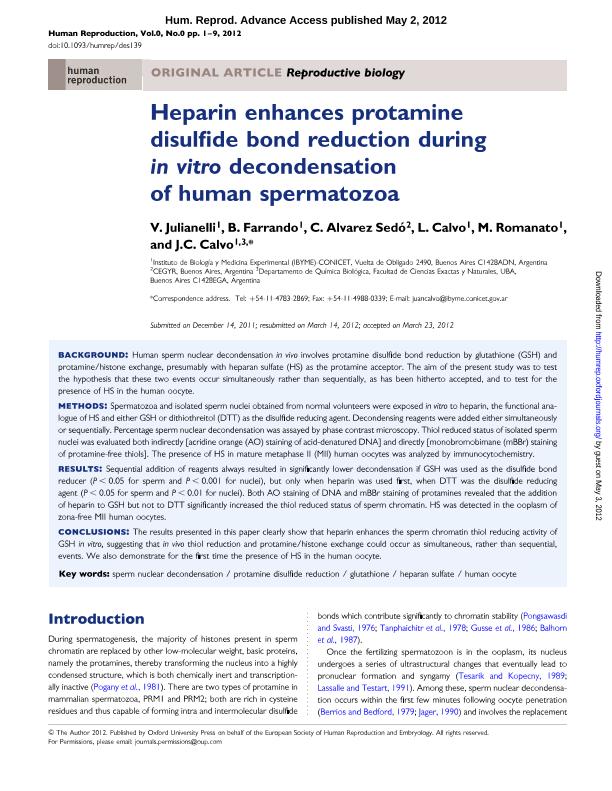Artículo
Heparin enhances protamine disulfide bond reduction during in vitro decondensation of human spermatozoa
Julianelli, Vanina Laura ; Farrando, Bárbara; Alvarez Sedó, C.; Piñeiro, Lucrecia; Romanato, Marina
; Farrando, Bárbara; Alvarez Sedó, C.; Piñeiro, Lucrecia; Romanato, Marina ; Calvo, Juan Carlos
; Calvo, Juan Carlos
 ; Farrando, Bárbara; Alvarez Sedó, C.; Piñeiro, Lucrecia; Romanato, Marina
; Farrando, Bárbara; Alvarez Sedó, C.; Piñeiro, Lucrecia; Romanato, Marina ; Calvo, Juan Carlos
; Calvo, Juan Carlos
Fecha de publicación:
02/05/2012
Editorial:
Oxford University Press
Revista:
Human Reproduction
ISSN:
0268-1161
e-ISSN:
1460-2350
Idioma:
Inglés
Tipo de recurso:
Artículo publicado
Clasificación temática:
Resumen
BACKGROUND: Human sperm nuclear decondensation in vivo involves protamine disulfide bond reduction by glutathione (GSH) and protamine/histone exchange, presumably with heparan sulfate (HS) as the protamine acceptor. The aim of the present study was to test the hypothesis that these two events occur simultaneously rather than sequentially, as has been hitherto accepted, and to test for the presence of HS in the human oocyte. METHODS: Spermatozoa and isolated sperm nuclei obtained from normal volunteers were exposed in vitro to heparin, the functional analogue of HS and either GSH or dithiothreitol (DTT) as the disulfide reducing agent. Decondensing reagents were added either simultaneously or sequentially. Percentage sperm nuclear decondensation was assayed by phase contrast microscopy. Thiol reduced status of isolated sperm nuclei was evaluated both indirectly [acridine orange (AO) staining of acid-denatured DNA] and directly [monobromobimane (mBBr) staining of protamine-free thiols]. The presence of HS in mature metaphase II (MII) human oocytes was analyzed by immunocytochemistry. RESULTS: Sequential addition of reagents always resulted in significantly lower decondensation if GSH was used as the disulfide bond reducer (P < 0.05 for sperm and P < 0.001 for nuclei), but only when heparin was used first, when DTT was the disulfide reducing agent (P < 0.05 for sperm and P < 0.01 for nuclei). Both AO staining of DNA and mBBr staining of protamines revealed that the addition of heparin to GSH but not to DTT significantly increased the thiol reduced status of sperm chromatin. HS was detected in the ooplasm of zona-free MII human oocytes. CONCLUSIONS: The results presented in this paper clearly show that heparin enhances the sperm chromatin thiol reducing activity of GSH in vitro, suggesting that in vivo thiol reduction and protamine/histone exchange could occur as simultaneous, rather than sequential, events. We also demonstrate for the first time the presence of HS in the human oocyte.
Archivos asociados
Licencia
Identificadores
Colecciones
Articulos(IBYME)
Articulos de INST.DE BIOLOGIA Y MEDICINA EXPERIMENTAL (I)
Articulos de INST.DE BIOLOGIA Y MEDICINA EXPERIMENTAL (I)
Citación
Julianelli, Vanina Laura; Farrando, Bárbara; Alvarez Sedó, C.; Piñeiro, Lucrecia; Romanato, Marina; et al.; Heparin enhances protamine disulfide bond reduction during in vitro decondensation of human spermatozoa; Oxford University Press; Human Reproduction; 27; 7; 2-5-2012; 1930-1938
Compartir
Altmétricas



